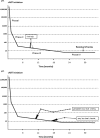Significance and clinical management of persistent low-level viremia and very-low-level viremia in HIV-1-infected patients
- PMID: 24733471
- PMCID: PMC4068602
- DOI: 10.1128/AAC.00076-14
Significance and clinical management of persistent low-level viremia and very-low-level viremia in HIV-1-infected patients
Abstract
A goal of HIV therapy is to sustain suppression of the plasma viral load below the detection limits of clinical assays. However, widely followed treatment guidelines diverge in their interpretation and recommended management of persistent viremia of low magnitude, reflecting the limited evidence base for this common clinical finding. Here, we review the incidence, risk factors, and potential consequences of low-level HIV viremia (LLV; defined in this review as a viremia level of 50 to 500 copies/ml) and very-low-level viremia (VLLV; defined as a viremia level of <50 copies/ml detected by clinical assays that have quantification cutoffs of <50 copies/ml). Using this framework, we discuss practical issues related to the diagnosis and management of patients experiencing persistent LLV and VLLV. Compared to viral suppression at <50 or 40 copies/ml, persistent LLV is associated with increased risk of antiretroviral drug resistance and overt virologic failure. Higher immune activation and HIV transmission may be additional undesirable consequences in this population. It is uncertain whether LLV of <200 copies/ml confers independent risks, as this level of viremia may reflect assay-dependent artifacts or biologically meaningful events during suppression. Resistance genotyping should be considered in patients with persistent LLV when feasible, and treatment should be modified if resistance is detected. There is a dearth of clinical evidence to guide management when genotyping is not feasible. Increased availability of genotypic assays for samples with viral loads of <400 copies/ml is needed.
Copyright © 2014, American Society for Microbiology. All Rights Reserved.
Figures

Comment in
-
Feasibility and reproducibility of HIV-1 genotype resistance test in very-low-level viremia.Antimicrob Agents Chemother. 2014 Dec;58(12):7620-1. doi: 10.1128/AAC.03771-14. Antimicrob Agents Chemother. 2014. PMID: 25392538 Free PMC article. No abstract available.
References
-
- European AIDS Clinical Society 2013. European guidelines for treatment of HIV infected adults in Europe, version 6.1. European AIDS Clinical Society, Brussels, Belgium
-
- Panel on Antiretroviral Guidelines for Adults and Adolescents. 2013. Guidelines for the use of antiretroviral agents in HIV-1-infected adults and adolescents. Department of Health and Human Services Panel on Antiretroviral Guidelines for Adults and Adolescents, Rockville, MD: http://aidsinfo.nih.gov/contentfiles/lvguidelines/AdultandAdolescentGL.pdf
-
- Writing Group, Williams I, Churchill D, Anderson J, Boffito M, Bower M, Cairns G, Cwynarski K, Edwards S, Fidler S, Fisher M, Freedman A, Geretti AM, Gilleece Y, Horne R, Johnson M, Khoo S, Leen C, Marshall N, Nelson M, Orkin C, Paton N, Phillips A, Post F, Pozniak A, Sabin C, Trevelion R, Ustianowski A, Walsh J, Waters L, Wilkins E, Winston A, Youle M. 2012. British HIV Association guidelines for the treatment of HIV-1-positive adults with antiretroviral therapy. HIV Med. 13:S1–S85. 10.1111/hiv.12119 - DOI - PubMed
-
- Geretti AM, Smith C, Haberl A, Garcia-Diaz A, Nebbia G, Johnson M, Phillips A, Staszewski S. 2008. Determinants of virological failure after successful viral load suppression in first-line highly active antiretroviral therapy. Antivir. Ther. 169:927–936 - PubMed
-
- Greub G, Cozzi-Lepri A, Ledergerber B, Staszewski S, Perrin L, Miller V, Francioli P, Furrer H, Battegay M, Vernazza P, Bernasconi E, Günthard HF, Hirschel B, Phillips AN, Telenti A, Frankfurt HIV Clinic Cohort and Swiss HIV Cohort Study 2002. Intermittent and sustained low-level HIV viral rebound in patients receiving potent antiretroviral therapy. AIDS 16:1967–1969. 10.1097/00002030-200209270-00017 - DOI - PubMed
MeSH terms
Substances
LinkOut - more resources
Full Text Sources
Other Literature Sources
Medical

